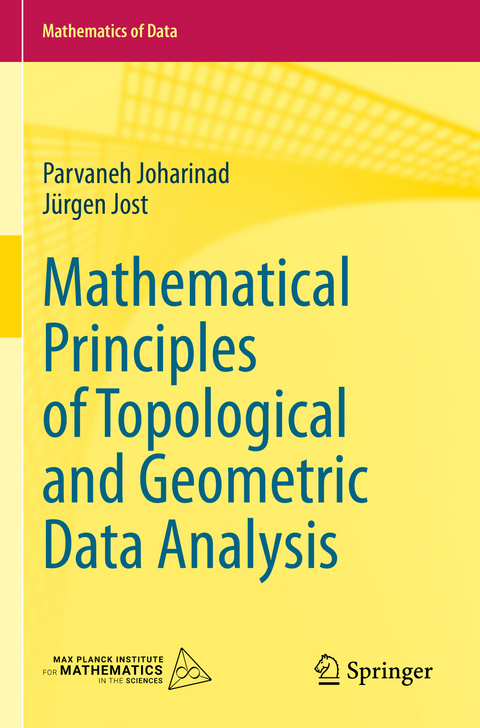
Mathematical Principles of Topological and Geometric Data Analysis
Springer International Publishing (Verlag)
978-3-031-33442-9 (ISBN)
This book explores and demonstrates how geometric tools can be used in data analysis. Beginning with a systematic exposition of the mathematical prerequisites, covering topics ranging from category theory to algebraic topology, Riemannian geometry, operator theory and network analysis, it goes on to describe and analyze some of the most important machine learning techniques for dimension reduction, including the different types of manifold learning and kernel methods. It also develops a new notion of curvature of generalized metric spaces, based on the notion of hyperconvexity, which can be used for the topological representation of geometric information.
In recent years there has been a fascinating development: concepts and methods originally created in the context of research in pure mathematics, and in particular in geometry, have become powerful tools in machine learning for the analysis of data. The underlying reason for this is that data are typically equipped with somekind of notion of distance, quantifying the differences between data points. Of course, to be successfully applied, the geometric tools usually need to be redefined, generalized, or extended appropriately.
Primarily aimed at mathematicians seeking an overview of the geometric concepts and methods that are useful for data analysis, the book will also be of interest to researchers in machine learning and data analysis who want to see a systematic mathematical foundation of the methods that they use.
Parvaneh Joharinad received her PhD in mathematics from Amirkabir University of Technology (Tehran Polytechnic), Tehran, Iran in March 2013. She worked as an assistant professor in the geometry group at the Institute for Advanced Studies in Basic Sciences (IASBS) in Zanjan, Iran, for seven years. She is interested in the use of geometry in data science and machine learning, and in particular in dimensionality reduction, a fundamental problem in topological and geometric data analysis.
Her collaboration with Jürgen Jost began in 2017, via a project on a generalization of the concept of sectional curvature to datasets. In 2020, she received a grant from the Max-Planck society to continue her collaboration at the Max-Planck Institute for Mathematics in the Sciences, Leipzig, Germany. As of August 2022, she started a new position at the Center for Scalable Data Analytics and Artificial Intelligence, as a senior postdoc.
Jürgen Jost worked as a Professor of Mathematics at Ruhr University Bochum from 1984 to 1996 and since 1996 has been director and a permanent member of the Max Planck Institute for Mathematics in the Sciences, Leipzig. In 1998 he became an Honorary Professor at the University of Leipzig. He is also an external member of the Santa Fe Institute for the Sciences of Complexity, New Mexico.
He pursues both topical research in different fields of pure mathematics and theoretical physics (Riemannian and algebraic geometry, geometric analysis, calculus of variations, partial differential equations, dynamical systems, graph and hypergraph theory) and interdisciplinary research in complex systems, including evolutionary and theoretical molecular biology, mathematical and theoretical neuroscience, nonlinear dynamics and statistical physics, economics and social sciences, strategy science, history and philosophy of science. He directs a group of about 40 scientists, postdocs and PhD students, and has manyinternational cooperation partners.
Introduction.- Topological foundations, hypercomplexes and homology.- Weighted complexes, cohomology and Laplace operators.- The Laplace operator and the geometry of graphs.- Metric spaces and manifolds.- Linear methods: Kernels, variations, and averaging.- Nonlinear schemes: Clustering, feature extraction and dimension reduction.- Manifold learning, the scheme of Laplacian eigenmaps.- Metrics and curvature.
| Erscheinungsdatum | 01.08.2024 |
|---|---|
| Reihe/Serie | Mathematics of Data |
| Zusatzinfo | IX, 281 p. 13 illus., 11 illus. in color. |
| Verlagsort | Cham |
| Sprache | englisch |
| Maße | 155 x 235 mm |
| Themenwelt | Mathematik / Informatik ► Mathematik ► Angewandte Mathematik |
| Schlagworte | category theory • curvature of metric spaces • dimension reduction • graph theory • Homology • Kernel technique • Laplace operators • manifold learning • Riemannian Geometry |
| ISBN-10 | 3-031-33442-6 / 3031334426 |
| ISBN-13 | 978-3-031-33442-9 / 9783031334429 |
| Zustand | Neuware |
| Haben Sie eine Frage zum Produkt? |
aus dem Bereich


